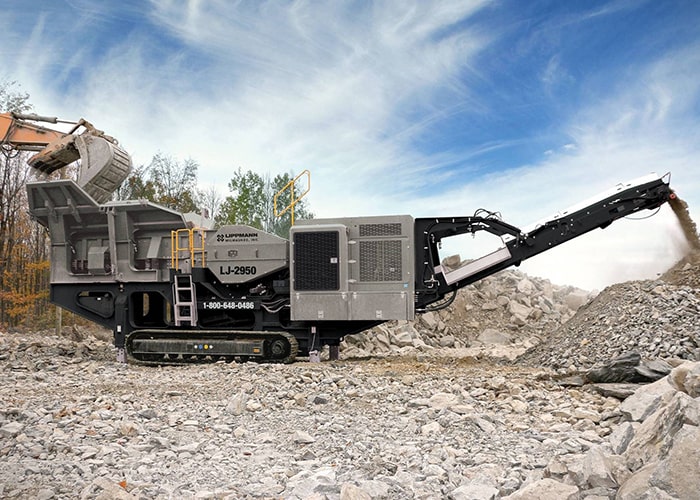The mining and construction industry thrives on powerful machinery to facilitate the robust and complex operations needed for material handling and crushing. Two significant players in the game are impact crushers and jaw crushers, the subject of an ongoing debate: impact crusher vs. jaw crusher. To unravel this dilemma, let’s delve deeper into the mechanisms, the performance, and the adaptability of both these powerful machines.
Understanding the Basic Concepts: Impact Crusher and Jaw Crusher
Jaw Crusher: A Brief Overview
The jaw crusher, commonly known as the rock jaw crusher, symbolizes a rudimentary crushing concept. It operates on the principle of compressive force for breaking down materials. Essentially, the material is squeezed between two heavy jaws or plates, one of which is moveable, leading to the crushing of the material.
Impact Crusher: The Core Features
Contrarily, the impact crusher, sometimes termed an impactor crusher, relies on impact force for crushing materials. It involves a high-speed rotor equipped with ‘blow bars’ or ‘hammers’ that collide with the material, causing it to shatter or fracture.
Impact Crusher vs. Jaw Crusher: Where Do They Excel?
Performance Comparison: Jaw Crusher vs. Impact Crusher
To understand the crux of the debate: jaw crusher vs. impact crusher, we need to compare their performance in various scenarios. While both types of crushers are versatile, their areas of specialization differ slightly.
With its superior compressive force, a jaw crusher is exceptional at crushing hard and abrasive materials like granite or basalt. But its crushing action is not as effective with more flexible materials or high water content.
On the other hand, the impact crusher provides a more consistent granular size and shape, ideal for producing high-quality end products. It performs exceptionally well with softer and slightly less abrasive materials, converting them into uniform, cubic shapes.
Adaptability: Meeting Different Needs
Jaw crushers are widely adopted for their adaptability in primary crushing, making them an excellent choice for applications requiring large feed sizes. They handle larger pieces of rock and can crush them into medium-sized fragments.
Contrarily, due to their high reduction ratio and cubic product shape, impact crushers are often preferred for secondary or tertiary crushing stages and recycling applications.
Crushing Capacities: Impact Crusher vs. Jaw Crusher
Assessing the crushing capacities of both the impact crusher and jaw crusher is integral to the ‘impact crusher vs. jaw crusher’ discourse. The primary determinants of a crusher’s capacity are its size (feed opening), motor power rating, and the material’s hardness.
With their large feed opening and aggressive crushing action, jaw crushers are renowned for their impressive throughput capacities. They can handle feed sizes larger than most other types of crushers, and they are exceptionally effective at reducing large rocks and ore pieces into smaller sizes suitable for further processing.
In contrast, impact crushers are usually used for crushing smaller-sized material, as the size reduction occurs upon impact. They excel at converting medium-hard to soft materials into finely crushed, uniform particles. Though lesser than jaw crushers when dealing with large-sized feed material, their capacity is unmatched when the focus shifts to producing smaller, uniformly shaped particles.
Thus, both crushers have their niches when it comes to crushing capacity. The jaw crusher excels in primary crushing where larger feed material is involved, whereas the impact crusher shines in applications requiring finer and more consistent particle size. Matching the crusher to the task at hand and the material being processed is crucial.
Cost Factor: Initial Investment and Operational Costs
The financial aspect of any industrial equipment acquisition is indeed a significant concern, making cost an important factor in the “impact crusher vs. jaw crusher” comparison.
When considering the initial investment, the jaw crusher tends to be less expensive compared to an impact crusher. The simpler design, fewer moving parts, and straightforward operation contribute to its lower upfront cost. The price can vary based on the model, size, and manufacturer.
At the same time, the impact crusher might carry a higher price tag initially. The complex design, high-tech features, and precision in manufacturing the high-speed rotor and blow bars account for the additional cost. But this can pay off in the long run, particularly if you require a crusher that can produce finely crushed, uniform particles.
As for operational costs, both types of crushers have their expense profiles. While low in complexity, jaw crushers might necessitate more frequent replacement of worn parts due to their crushing mechanism. This can lead to higher long-term costs.
On the other hand, the operating costs of impact crushers can be lower, as they generally have longer-lasting wear parts. But, keep in mind the cost of replacing the more complex parts of an impact crusher, when needed, can be high.
In essence, the decision between a jaw crusher and an impact crusher should take into account not only the upfront purchase cost but also the operational and maintenance costs over the equipment’s life. By examining these factors, you can make a financially sound decision that suits your functional requirements.
A Glimpse at the Small Crusher Machine Market
The demand for compact and efficient crushing solutions has given rise to the small crusher machine market. It caters to small-scale projects, construction sites, or areas with space limitations.
In this category, jaw crushers offer a cost-effective solution for contractors and small-scale operations. They are straightforward, easy to operate, and maintain, which makes them perfect for small-scale projects.
Impact crushers, too, offer excellent small-scale solutions. The compact versions of impactor crushers offer incredible efficiency in breaking down smaller pieces of material into finer, consistent outputs. They are ideal for producing high-quality aggregates or preparing material for further processing.
Final Thoughts: Choosing Between the Two
When considering an impact crusher vs. jaw crusher, the selection comes down to your specific requirements. A rock jaw crusher may serve you better if your project involves dealing with hard, abrasive materials. However, if you’re dealing with softer materials or require fine, uniform end products, an impactor crusher might be the way to go.
Both machines exhibit excellent performance in their respective domains, and each brings its unique set of benefits. Therefore, the choice depends heavily on the specific requirements of the project at hand. Understanding the key differences will help in making an informed decision. Remember, the best crusher enhances your operation’s efficiency, reduces costs, and aligns with your project’s unique needs.

